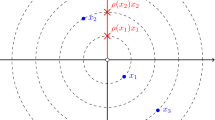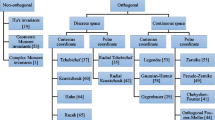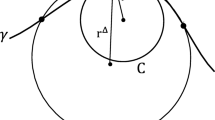Abstract
Combining implicit polynomials and algebraic invariants for representing and recognizing complicated objects proves to be a powerful technique. In this paper, we explore the findings of the classical theory of invariants for the calculation of algebraic invariants of implicit curves and surfaces, a theory largely disregarded in the computer vision community by a shadow of skepticism. Here, the symbolic method of the classical theory is described, and its results are extended and implemented as an algorithm for computing algebraic invariants of projective, affine, and Euclidean transformations. A list of some affine invariants of 4th degree implicit polynomials generated by the proposed algorithm is presented along with the corresponding symbolic representations, and their use in recognizing objects represented by implicit polynomials is illustrated through experiments. An affine invariant fitting algorithm is also proposed and the performance is studied.
Similar content being viewed by others
References
M.M. Blane, Z. Lei, and D.B. Cooper, “The 3L algorithm for fitting implicit polynomial curves and surfaces to data,” Brown University LEMS Lab. Technical Report, No. 160, Feb. 1997.
J.A. Dieudonn'e and J.B. Carrell, Invariant Theory, Old and New, Academic Press, 1971.
L.J.V. Gool, T. Moons, E. Pauvels, and A. Oosterlinck, “Foundations of semi-differential invariants,” Int. Journal of Computer Vision, Jan. 1993.
J.H. Grace and A. Young, The Algebra of Invariants, Cambridge Univ. Press, 1903.
G.B. Gurevich, Foundations of the Theory of Algebraic Invariants, P. Noordhoff, 1964.
D. Hilbert, Theory of Algebraic Invariants, Cambridge University Press, 1993.
C.M. Hoffman, “Implicit curves and surfaces in CAGD,” IEEE Computer Graphics and Applications, January 1993.
D. Keren, “Using symbolic computation to find algebraic invariants,” IEEE Transactions on Pattern Analysis and Machine Intelligence, Vol. 16, No. 11, pp. 1143-1149, 1994.
J.P.S. Kung and G.-C. Rota, “Invariant theory of binary forms,” Bull. of the Amer. Math. Soc., Vol. 10, No. 1, pp. 26-85, 1984.
Z. Lei and H. Civi, “Closed-form object pose estimation using algebraic shape representation,” Brown University LEMS Lab. Technical Report, No. 161, March 1997.
Z. Lei, H. Civi, and D.B. Cooper, “Free-form object modeling and inspection,” in Proceedings, Automated Optical Inspection for Industry, SPIE's Photonics China' 96, Beijing, China, Nov. 1996.
J.L. Mundy and A. Zisserman, Geometric Invariance in Machine Vision, MIT Press, 1992.
P. Olver, G. Shapiro, and A. Tennenbaum, “Differential invariant signatures and flows in computer vision: A symmetry group approach,” in Geometry-Driven Diffusion in Computer Vision, B.M.H. Romeny (Ed.), Kluwer Academic Press, 1995.
J. Ponce, D.J. Kriegman, S. Petitjean, S. Sullivan, G. Taubin, and B. Vijayakumar, “Representations and algorithms for 3D curved object recognition,” in Three-Dimensional Object Recognition Systems, A.K. Jain and P.J. Flynn (eds.), Elsevier Science Publishers, 1993, pp. 327-352.
G. Rayna, REDUCE: Software for Algebraic Computation, Springer-Verlag, 1987.
L.S. Shapiro, A. Zisserman, and M. Brady, “3D motion recovery via affine epipolar geometry,” Int. Journal of Computer Vision, Vol. 16, pp. 147-182, 1995.
B. Sturmfels, Algorithms in Invariant Theory, Springer-Verlag, 1993.
J. Subrahmonia, D.B. Cooper, and D. Keren, “Practical reliable bayesian recognition of 2D and 3D objects using implicit polynomials and algebraic invariants,” IEEE Transactions on Pattern Analysis and Machine Intelligence, May 1996, pp. 505-519.
G. Taubin and D.B. Cooper, “2D and 3D object recognition and positioning with algebraic invariants and covariants,” in Symbolic and Numerical Comput. for Artif. Intelligence, B.R. Donald, D. Kapur, and J.L. Mundy (Eds.), Academic Press, 1992.
I. Weiss, “Geometric invariants and object recognition,” Int. Journal of Computer Vision, Vol. 10, No. 3, pp. 207-231, 1993.
Author information
Authors and Affiliations
Rights and permissions
About this article
Cite this article
Civi, H., Christopher, C. & Ercil, A. The Classical Theory of Invariants and Object Recognition Using Algebraic Curve and Surfaces. Journal of Mathematical Imaging and Vision 19, 237–253 (2003). https://doi.org/10.1023/A:1026233121583
Issue Date:
DOI: https://doi.org/10.1023/A:1026233121583




